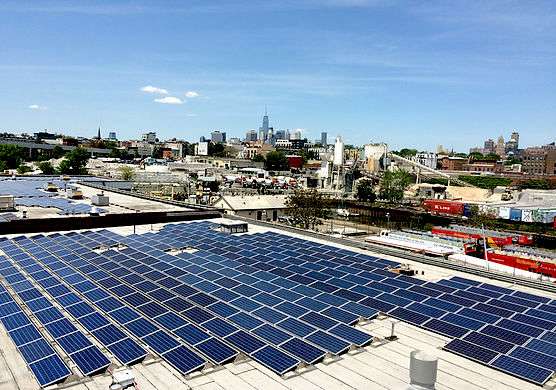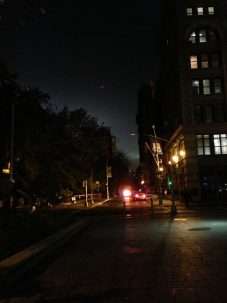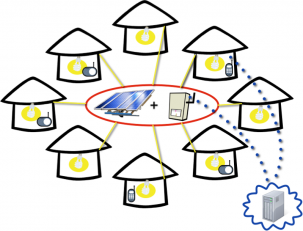Taking steps toward the 21st century smart grid

In 2016, the United States experienced 3,879 blackouts of more than 48 minutes that affected over 18 million people. A recent poll says nearly two-thirds of Americans believe the national power grid is vulnerable to a cyber or physical attack; even more say they are unprepared for an extended outage.
In Brooklyn, N.Y., a group of residents and businesses have joined forces to form the Brooklyn Microgrid, in part, so that when the next blackout occurs, they will be able generate and store their own energy. The Brooklyn Microgrid, set in a five-square block area of Gowanus and Park Slope, is a network of solar panel owners whose energy sources are linked together and, while still connected to the main grid, are able to operate independently as a single entity if power is lost. The network had 50 participants as of March.
The project, owned by LO3 Energy, is also designed to enable users ("prosumers") to store or sell any excess electricity they produce to their consumer neighbors in a "peer-to-peer energy system" using blockchain, a database technology adopted from the financial sector. Blockchain enables transactions between sellers and buyers in real time without an intermediary, through a common, tamper-proof record of all transactions kept on the networked computers. Eventually, private owners could produce electricity and sell it directly to other consumers through trading renewable energy credits or, one day, by selling electricity directly. They would still, however, pay Con Edison for infrastructure maintenance and service.
Now in its early stages, the Brooklyn Microgrid is measuring energy production through data from meters installed in prosumers' homes and testing a smartphone app that will enable users to control the source of their energy and how much they are willing to pay for it.
Microgrids have been around for years, but traditional microgrids have usually served only one user, such as a hospital or university. Microgrids connect homes and businesses with local power generation and battery storage. They may utilize conventional energy sources or renewable energy, and are connected to the main grid, but have the ability to "island," i.e., to function independently of the grid.
For example, New York University's combined heat and power microgrid, built in 2011, kept many of NYU's buildings lit during Superstorm Sandy when most of lower Manhattan lost power.
In addition to providing power during blackouts, microgrids can add resilience to the existing grid infrastructure and save money by postponing the need to invest in grid upgrades. They add flexibility, increase reliability and can reduce energy costs by helping the grid meet peak energy demands. If energy is not used immediately, it can be stored; this reduces waste and helps smooth out the intermittency of renewable energy flow. When run on renewable energy, microgrids can lessen carbon and other emissions. A community microgrid like Brooklyn Microgrid can also keep money for electricity within the community, create jobs, encourage community investments and reduce the cost of community disaster services. The NYU microgrid saves the university $5-8 million each year in energy costs and reduces greenhouse gas emissions by 20 percent.
New York has about 20 established microgrids, including both institutional and community projects. They seem like an obvious solution to a number of the energy challenges we have, so why aren't there more of them?
New York City was the first place to have an electric grid, explained Steve Cohen, executive director of the Earth Institute and director of the Master of Public Administration Program in Environmental Science and Policy at Columbia University's School of International and Public Affairs. Now a century old, the grid was built one section at a time as the city grew, constructed during the industrial age when industry was vertically integrated and highly centralized.
Today, however, most industry is decentralized and networked—organizations buy components from others instead of making everything themselves. "Instead of having a lot of inventory and spending a lot of money on it," Cohen said, "you buy it as you need it because you know you can get it. The only part of the economy that hasn't decentralized is energy."
"The model of a highly centralized energy system with big power plants in a few places, distributing energy out on the grid to individuals' homes and businesses, is an old-fashioned, wasteful and pretty vulnerable model," Cohen said. "The notion of a smart grid is that we would have two-way generation of energy controlled by computers so that the supply would match the need, and if you didn't need the energy, you'd have storage facilities to store it until you did…

"The purpose of a microgrid is to start the process of building the smart grid of the 21st century. You're not going to build it all at once, because it would cost too much money and take too much time. So we will create the smart grid by accumulating microgrids, which is pretty much how the original grid was created."
Gov. Cuomo's Reforming the Energy Vision strategy aims to make New York's energy system cleaner, stronger and more resilient, and bring it into the 21st century. One of its initiatives is the NY Prize, a $40 million competition to help communities create microgrids. In 2015, over $8 million was awarded to 83 projects for feasibility studies; 11 projects received $1 million each this year for design and business planning. Prize winners for the build-out phase will be announced in 2018.
The Environmental Science and Policy Program culminates with capstone projects working with real world clients on real problems. Since most of the analyses of microgrids have focused on technical issues, Cohen tasked his students with examining the regulatory, legal and financial obstacles and opportunities for microgrids. The client was the New York Power Authority, the nation's largest state-owned utility. The students set out to understand the changes that are happening in the energy system and the power authority's potential role in that shift.
"Everyone would agree that we want an energy grid that is efficient, resilient to natural disasters, and cheap to operate," said Johnathan de Villier, student deputy manager of the project. "The vision is not the problem, but somehow that vision has not been realized yet…We talked to over 40 experts in all different areas—at utilities, generation companies, private companies getting into electricity markets, and those involved in community-scale microgrid projects. Our main conclusion is that the technology isn't really the problem."
"There's a lot of amazing technology out there that's ready to be implemented," McKenzie Schwartz, the student project manager, said. "The barriers right now are regulatory and organizational. The Public Service Commission, New York's oversight body for energy, has policies that weren't developed at a time when decentralized energy was part of the consciousness. So these microgrid projects must go through all the approvals on a case-by-case basis, and it's a really slow process. It also makes it challenging to get funding if you're not sure when you're going to get approved or if you will get approved."
As it stands, anyone who wants to install some sort of distributed generation facility (that generates power at the point of consumption) is considered to be a utility and is subject to the same regulations as a massive coal plant. If the same kinds of fees and regulations are leveled on a community group planning a microgrid, it could be cost-prohibitive. Moreover, each microgrid project must apply individually to be exempt from these rules. Approval for microgrids takes on average 407 days.
"A really impactful thing would be to develop a policy that's based on the type of technology being installed or the size of the technology, the megawatts involved," Schwartz said. "So that you don't have to apply for exemption, you'd automatically be exempted from that rule. Rethinking policies like that would really speed up these processes."
In their final report, the students will recommend that, since the New York Power Authority is interested in facilitating microgrid projects, it should create a working group of diverse stakeholders to figure out the most efficient and least costly way to get through the process. The working group should also define who qualifies for exemptions, examine right-of-way issues, and determine how best to update regulations to keep pace with the technology. The power authority could eventually exert pressure on the Public Service Commission that makes the rules.
The students also found a financial barrier: There is no single financial model for how to make microgrids profitable for the people involved. "That involves balancing the needs of the consumers attached to those microgrids, the prosumers, with the needs of utilities and traditional business models," de Viller said.
The students are recommending that the New York Power Authority work with other state agencies to come up with a standardized financial model for microgrids. Who would supply the equity? If someone decides to finance a microgrid, how would the money be recouped? How can microgrids be financed in a way that upfront capital costs are not prohibitive? Another recommendation is that the authority partner with the NY Green Bank, which funds and promotes clean technology, to develop a new standard power purchase agreement specifically for microgrids.
The power authority should also create a blueprint for the ownership of microgrids and distributed energy resources, the students said. Who should own the infrastructure of a microgrid—the community or the utility? Where should excess electricity be stored and who would own the storage and its revenue stream?

"The utilities don't necessarily want to do this because they have a monopoly on the generation of energy," Cohen said. "But they have no choice, because every electric utility is heavily regulated by the government."
"The state is heavily promoting microgrids, so it's happening," Schwartz said. "But it can actually help them [the utilities] save costs. New York's energy grid is aging in areas, so rather than having to completely retrofit the old system, you can install these distributed technologies instead."
In 2014, the Public Service Commission approved Con Edison's plan to address a 69- megawatt shortfall of power in Brooklyn and Queens by developing several microgrids at a cost of $200 million. This enabled the utility to avoid spending $1 billion on a new substation and other infrastructure.
Utilities could potentially make additional revenue as energy system managers. The New York Power Authority currently has a program that collects data about how electricity is consumed and used across its projects. The data is analyzed and used to simulate potential changes to the system to see how they would affect rates, demand on peak days, efficiency and other aspects of the energy system. Currently, the data helps the authority make strategic decisions for the future but is not used to take direct action. The students are suggesting that, in the future, the authority could act as an intermediary data aggregator, using the data from its network of smart meters and monitors to help move resources around the system based on what's happening in real time. The authority could receive income for providing the service.
Ultimately, homeowners or businesses could conceivably generate, sell and buy electricity through automated processes that completely cut utilities out of the picture. The utilities might then become the entities that maintain the infrastructure that makes the energy system possible, but not be involved in the generation or sale of electricity.
The students' final recommendation is that the power authority experiment with blockchain in several of its microgrid projects. The vision is to have a smart phone app facilitating contracts so that people can arrange to sell electricity when prices get within a certain range, or to buy or store electricity when their price range is met. The power authority could charge for membership in the blockchain and operate it.
Microgrids are in development in Newport, R.I., Mesa del Sol, N.M., and other states. Hudson Yards, Manhattan's latest real estate development, has its own microgrid that runs on natural gas and diesel. The U.S. Air Force is studying a mobile and self-sustaining microgrid for expeditionary military forces that can be built in one hour, with solar panels on tents and the hardware, software and batteries in a trailer. UC San Diego's advanced microgrid, powered by a fuel cell, solar panels and combined heat and power, produces 92 percent of the electricity used on its campus.
Hartley Bay in British Columbia, Canada, a remote community where electricity was traditionally very expensive due to the cost of transport and delivery, is now served by a smart microgrid system incorporating diesel and renewable resources.
In 2011, Vijay Modi, a professor of mechanical engineering at Columbia, established 16 microgrid pilot projects in rural villages in Mali and Uganda. Each SharedSolar microgrid combined small solar power plants with battery storage, providing electricity for about 20 families. That same year, in Sendai, Japan, a microgrid at Tohoku Fukushi University kept the lights on after the Fukushima disaster when the rest of Sendai went dark.
"You see all these climate projections about our world and how we're all going to be under water," Cohen said. "In order for that not to happen, things like microgrids have to happen. This is the day-to-day, roll-up-your-sleeves work of the transition to a renewable energy economy. The fact that state governments are doing it on a daily basis is why I'm optimistic…The history of civilization shows that technology dominates all political efforts to contain it."
Provided by Earth Institute, Columbia University
This story is republished courtesy of Earth Institute, Columbia University: blogs.ei.columbia.edu



















